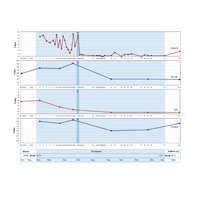Extending Blatt’s two-polarity model of personality development to dissociative identity disorder: a theory-building case study

Submitted: October 20, 2020
Accepted: March 24, 2021
Published: March 31, 2021
Accepted: March 24, 2021
Abstract Views: 2695
PDF: 1021
HTML: 37
HTML: 37
Publisher's note
All claims expressed in this article are solely those of the authors and do not necessarily represent those of their affiliated organizations, or those of the publisher, the editors and the reviewers. Any product that may be evaluated in this article or claim that may be made by its manufacturer is not guaranteed or endorsed by the publisher.
All claims expressed in this article are solely those of the authors and do not necessarily represent those of their affiliated organizations, or those of the publisher, the editors and the reviewers. Any product that may be evaluated in this article or claim that may be made by its manufacturer is not guaranteed or endorsed by the publisher.
Similar Articles
- Kiran Boone, Kennedy M. Balzen, Carla Sharp, Impairment in personality functioning predicts young adult suicidal ideation and suicide attempt above and beyond depressive symptoms , Research in Psychotherapy: Psychopathology, Process and Outcome: Vol. 27 No. 3 (2024)
- John S. Auerbach, The contributions of Sidney J. Blatt: a personal and intellectual biography , Research in Psychotherapy: Psychopathology, Process and Outcome: Vol. 20 No. 1 (2017)
- Saryn R. Levy, Mark J. Hilsenroth, Francine Conway, Jesse Owen, Patient personality characteristics and therapeutic integration: treating borderline personality and emotionally dysregulated-dysphoric personality features , Research in Psychotherapy: Psychopathology, Process and Outcome: Vol. 25 No. 2 (2022)
- Samantha Reis, Emily L. Matthews, Brin F.S. Grenyer, Characteristics of effective online interventions: implications for adolescents with personality disorder during a global pandemic , Research in Psychotherapy: Psychopathology, Process and Outcome: Vol. 23 No. 3 (2020)
- Andrzej Werbart, Siri Aldèn, Anders Diedrichs, Changes in the anaclitic-introjective personality configurations following psychoanalytic psychotherapy with young adults , Research in Psychotherapy: Psychopathology, Process and Outcome: Vol. 20 No. 1 (2017)
- Osmano Oasi, Laura Buonarrivo, Alberto Codazzi, Margherita Passalacqua, Gio Matteo Risso Ricci, Francesca Straccamore, Roberto Bezzi, Assessing personality change with Blatt's anaclitic and introjective configurations and Shedler-Westen Assessment Procedure profiles: two case studies in psychodynamic treatment , Research in Psychotherapy: Psychopathology, Process and Outcome: Vol. 20 No. 1 (2017)
- Aija de Starceva-Apele, Malgozata Rascevska, Reliability and factorial validity of long and brief versions of the inventory of personality organization in a Latvian sample , Research in Psychotherapy: Psychopathology, Process and Outcome: Vol. 25 No. 2 (2022)
- Vittorio Lingiardi, Nancy McWilliams, Laura Muzi, The contribution of Sidney Blatt's two-polarities model to the Psychodynamic Diagnostic Manual , Research in Psychotherapy: Psychopathology, Process and Outcome: Vol. 20 No. 1 (2017)
- CV Vijayapriya, Rameshbabu Tamarana, Effectiveness of internet-delivered dialectical behavior therapy skills training on executive functions among college students with borderline personality traits: a non-randomized controlled trial , Research in Psychotherapy: Psychopathology, Process and Outcome: Vol. 26 No. 3 (2023)
- Annalisa Tanzilli, Flavia Fiorentino, Marianna Liotti, Gabriele Lo Buglio, Ivan Gualco, Vittorio Lingiardi, Carla Sharp, Riccardo Williams , Patient personality and therapist responses in the psychotherapy of adolescents with depressive disorders: toward the Psychodynamic Diagnostic Manual - third edition , Research in Psychotherapy: Psychopathology, Process and Outcome: Vol. 27 No. 1 (2024)
You may also start an advanced similarity search for this article.

 https://doi.org/10.4081/ripppo.2021.505
https://doi.org/10.4081/ripppo.2021.505




